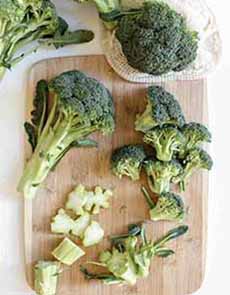RECIPE: Broccoli Madness Salad & The History Of Broccoli
|
For green fare on St. Patrick’s Day, try this very green broccoli salad from Souplantation. It has plenty of added ingredients (bacon! raisins! cashews!) to make it a crowd pleaser.
National Broccoli Day Is March 22nd. > The history of broccoli is below. Ingredients For 6 Side Salad Servings 1. WASH the broccoli and pat dry. Chop off the bottom 2 inches or so of stems and break the head into florets. 2. PLACE the florets in a large bowl; add the bacon, cashews, raisins, and red onion. 3. MAKE the dressing: Combine the mayonnaise, sugar, and cider vinegar in a small bowl; stir until smooth. 4. TOSS the broccoli mixture with the dressing. Let it set 10 minutes or longer before serving. Serve on chilled salad dishes. |
 [1] An easy broccoli salad, sure to please all (photo © Souplantation [now closed]).
|
|
|
THE HISTORY OF BROCCOLI If you’ve even thought that a head of broccoli looked like a little tree with robust stalks and branches—well, it got its name from the Latin brachium, which means strong arm or branch. Broccoli resulted from breeding of landrace* [local] Brassica† crops in the northern Mediterranean starting around the sixth century B.C.E. Modern broccoli has its origins in primitive cultivars‡ grown in the Roman Empire and was most likely improved via selective breeding in the southern Italian Peninsula or in Sicily. Ancient Romans enjoyed their broccoli in the centuries B.C.E. The son of Roman Emperor Tiberius (42 B.C.E. to 37 C.E.), Drusus Julius Caesar (14 B.C.E. to 23 C.E.), was so infatuated with broccoli that he forsook all other foods except Broccoli ala Apicius (with a mixture of cumin, coriander seeds, chopped onion, oil, and sun-made wine) for an entire month. Legend has it, that his broccoli binge turned his urine bright green [source]. Broccoli spread to northern Europe by the 18th century and in the U.S., Thomas Jefferson was growing broccoli at his Virginia home, Monticello [source: ibid.] But it was the 19th-century immigration to the U.S. by Italian immigrants that engendered broccoli cultivation and introduced the green vegetable to other Americans. After World War II, the breeding of U.S. and Japanese F1 hybrids (from distinctly different parental types) increased yields, quality, growth speed, and regional adaptation, which produced the cultivars that have been the most popular since then (“Premium Crop,” “Packman,” and “Marathon” [source]. Alas, broccoli cannot be harvested using machines, meaning it must be hand-harvested. That keeps prices up. Today, California produces 92% of U.S. broccoli, harvesting it year-round. Arizona is in a far second. Some 95% of the total crop is sold fresh (as opposed to frozen); some 15-20% of broccoli is exported to Canada, Japan, and Taiwan. The U.S. ranks 3rd in the world for broccoli, with China #1, and India #2 [source]. In 2019, global production of broccoli (combined for production reports with cauliflowers) was 27 million tonnes‡, with China and India together accounting for 73% of the world total.[13] Secondary producers, each having about one million tonnes or less annually, were the United States, Spain, and Mexico [source]. ________________ *The term “landrace” is generally defined as a cultivated, genetically heterogeneous variety of plant (or animal) that has evolved in a certain ecogeographical area and is therefore adapted to the edaphic and climatic conditions and to its traditional management and uses. It is a traditional, locally adapted, variety of a species of plant that has developed over time, through adaptation to its natural environment, and due to isolation from other populations of the species. Here’s more about it. †Brassica is a genus of plants in the cabbage and mustard family. The members of the genus are informally known as cruciferous vegetables and include arugula, bok choy, broccoli, Brussels sprouts, cabbage, cauliflower, collard greens, horseradish, kale, kohlrabi, mizuna, mustard greens, radish, rapeseed/canola, rapini (broccoli rabe), rutabaga, tatsoi, and turnips. Brassicas are members of the Brassicaceae family of cancer-fighting superfoods. “Cruciferous” derives from cruciferae, New Latin for “cross-bearing.” The flowers of these vegetables consist of four petals in the shape of a cross. They’re low in calories and high in fiber, vitamins, and minerals. You can’t eat too many of them, but you can overcook them. You’ll know they’re overcooked when an unpleasant sulfur aroma appears. They’ll also fade in color. That’s because all cruciferous vegetables contain chemical compounds that, when exposed to heat for a sufficient amount of time, produce hydrogen sulfide. A cultivar is a type of plant that people have bred for desired traits (selective breeding), which are reproduced in each new generation by a method such as grafting, tissue culture, or carefully controlled seed production. ‡A tonne is a metric unit of mass equal to 1,000 kilograms. It is also referred to as a metric ton to distinguish it from the non-metric units of short ton, and long ton. It is equivalent to approximately 2,204.6 pounds, 1.102 short tons, and 0.984 long tons. CHECK OUT WHAT’S HAPPENING ON OUR HOME PAGE, THENIBBLE.COM. |
||



